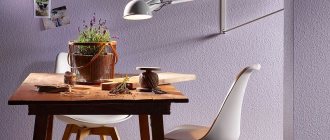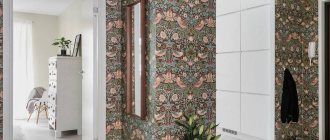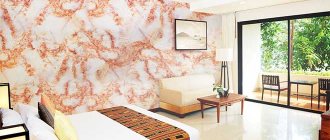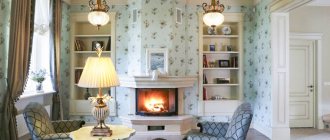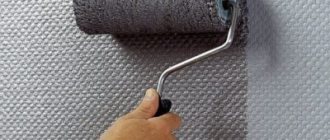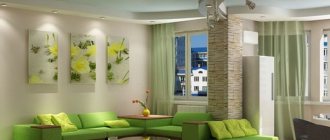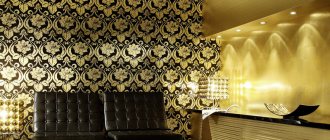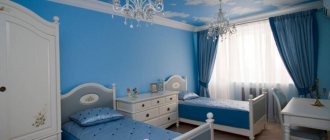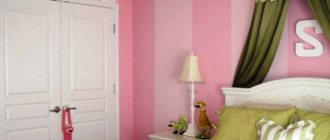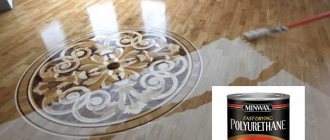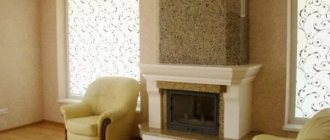Wall paint color palette
The chosen palette of wall paint colors is a very significant factor in the final appearance of the room. You must understand that all colors are divided into two large groups: warm and cold, but at the same time, they can be combined, although, at first glance, this may seem impossible.
So, for example, if you take contrasting colors for water-based paint, you can enhance one color with another, thereby enhancing the effect of its perception. In addition, by playing with colors, you can change the geometric visual perception of the room.
How do different colors of paint affect a person’s subconscious?
When choosing a palette of paint colors for walls, the effect of a particular color on a person’s psychological state must be taken into account. Below you can find general data on the effects of primary paint colors on our brain.
White color. This color makes the room spacious and comprehensive. But if you use exclusively white color or its superiority over other colors is repeated, then the room will become uncomfortable, and may also seem boring to many.
Red color. This color produces an exciting effect on the human body. If you plan to use red in the wall paint color palette, you must understand that you cannot overdo it, otherwise the room will quickly tire a person.
Yellow.
How to paint wallpaper: select paint, prepare walls
First you need to decide on the wallpaper material and type of paint. This will allow you to indicate the color and choose a combination of shades and patterns.
Features of the paints are as follows:
- Water-based and acrylic samples are the most popular, have no chemical odor and meet all sanitary standards.
- Latex materials are more expensive, easy to process, and environmentally friendly.
- Matte paints hide unevenness and minor defects of the treated surface.
- Glossy materials form a resistant film, which makes them suitable for use in rooms with high humidity.
The most common paint for walls is acrylic: it is suitable for most surfaces and allows the walls to “breathe”
For non-woven wallpaper, it is not recommended to use paints containing active chemicals that can ruin the structure of the pattern.
Wall paint color palette
This is a great color for temporary breakout rooms such as a dining room or loggia. It tones the body and provokes an influx of vitality.
Blue. This color has a calming effect on the human body and even helps normalize blood pressure. It is for these reasons that it is used along with the color green, which signals the brain to calm down, in a variety of medical settings. In everyday life, this color is ideal for the bathroom.
Orange color. If you use orange in the wall paint color palette, you must understand that despite the fact that it stimulates the human body to start the processes of restoring strength, you cannot overdo it with it, or it will begin to make you feel drowsy.
Purple. This color stimulates the body to concentrate mental activity, while it relaxes the nervous system and clears the mind for creativity.
Interesting techniques with paint colors and secrets of use.
There are several factors that you should consider during the process when choosing a palette of wall paint colors:
- The same paint can look different on different surfaces. So, on a smooth surface the colors look lighter, on a rough surface - darker, on a matte surface - they become warmer, even if they are initially considered cold, on a polished surface - they give off freshness, even if it is a warm and hot red color;
- If you are looking for a bright interior, then the simplest and most effective option would be to paint adjacent walls in contrasting colors;
- Despite the fact that walls are usually used as a backdrop for interior items, you can do things a little differently. Namely, make interior items complement the main theme set by the painted walls. So, your interior will look more lively and juicy.
Coloring paint for walls palette. Classic palette of modern colors
“Alien” colors can add age, give the skin an unhealthy look, and unsightly shade the hair and eyes. While “your” palette will highlight the skin and highlight the natural blush and pigment of the lips. To learn how to choose colors for yourself, you need to understand how they differ.
All the shades that surround us are derived from three basic ones: red, blue and yellow. Mixing them gives us the colors of the second order - orange, green and purple. And with their help you can get any tone from the spectrum.
How to determine cool and warm colors?
The most primitive classifications suggest considering the entire yellow-orange-red part of the color wheel as warm shades, and blue-green-violet as cold shades. This is not entirely true, since such pure colors are usually found only in pictures. In practice, everything is different: clothing designers, for example, strive to use interesting, complex, mixed options. The difference between cool and warm shades of colors is what undertone each of them has: cool blue or warm orange.
It is important to understand and remember that any color can be warmer or colder - blue, purple or red, and select the shade individually in each case.
What are these warm colors?
- In yellow: mustard, sea buckthorn, curry, saffron, amber, sulfur yellow, sunflower, honey and egg yolk.
- In red: brick, coral, copper red, fiery red, tomato, poppy red, cinnabar, pomegranate and the like.
- In green: olive, khaki, pear, linden, myrtle, green pea, forest green and others.
- In blue: sky blue, petrol, moray, cornflower blue, turquoise, protective blue, sea green and so on.
What are these cool colors?
Color types of appearance and colors
To determine which, warm or cold, colors in clothes suit you, you need to understand which of the 4 color types you belong to:
Spring
. Warm color type. People of this type have light, transparent, bronze-golden or ivory skin. The eyes are usually blue, green or hazel. Hair can range from light to brown and can be straw, honey-copper or golden brown curls.
Autumn
. The second warm color type. The skin is transparent white to slightly golden. Eyes can be either light blue or the entire golden brown range (amber, brown, red, and so on). Autumn hair also includes warm shades: copper-gold, red and red-brown and the like.
Winter
. This cool color type is distinguished by flawless porcelain skin, which almost always has a bluish undertone. Eyes - all shades of ice blue, gray or brown (there are, however, also green). The hair is always contrasting, dark (from thick chestnut to blue-black).
Summer
. Representatives of this color type have milky, pale or olive skin, but always with a cool undertone. Eyes are “cool”: gray, gray-blue, light green. Hair can be light brown, also with an ashy tint. But even if “summer” has dark curls, there is still no “red” in them - just like “winters”, they will always have a silver-gray base.
Recommendations for coloring
You can do any interior finishing work yourself. In addition to saving money, there is no doubt about future results.
Advice When painting wallpaper you need to be careful and careful. There is no need to use more than three colors, paint using similar and pre-selected shades.
Using construction tape you can achieve beautiful borders. Instead, you can use mosaics, paper borders, moldings or wooden slats.
When buying paint, it is advisable to perform calculations and add about 30% to the result obtained. This must be done when tinting the paint and again obtaining the same shade.
Product with texture
To glue wallpaper for painting, you need to prepare the necessary tools and materials:
- roller;
- brushes;
- construction tape.
When choosing paint, you need to take into account the characteristics of some building materials.
For example, water-based paint is suitable for paper coverings and non-woven wallpaper. Acrylic or latex coating is suitable for fiberglass wallpaper. When choosing a paint coating, the type of maintenance of the finished surfaces after completion of the repair is taken into account. First, two layers of the selected coating are applied to the wallpaper, leaving at least 60 minutes between each layer. But you need to remember that with repeated staining, the relief of the canvas is reduced.
When selecting several paints to highlight the boundaries of shades, it is advisable to use a brush.
Such products are easy to paint with your own hands.
When combining different shades in the decoration of ceilings or walls, you can set different goals:
- Diluting or adding accents.
- Creation of a certain style in interior design.
- Exhibiting creative and imaginative ideas.
- Zoning in one multifunctional room.
This cannot be achieved with ordinary wallpaper.
Living room in modern style
When painting walls with several shades, you should remember some rules:
- You can combine related colors (mint, blue, etc.).
- Choice of opposite shades (orange with blue, red with green).
- Combine tones belonging to the same scale. They can differ only in saturation.
You should also think about the method of combining shades. To obtain smooth borders, masking tape is suitable, and an aluminum profile is used to connect the colors in the protruding corner.
You can combine related colors
The optimal coloring option is horizontal division, when the lower tone is painted over 1/3 of the entire surface height. This is a classic method, identical to decorating with panels, and is suitable for modern interiors and children's rooms. You can paint walls using other methods, showing imagination and creativity.
Creative people can decorate the interior using walls painted using the figured method. They reflect anything, including waves, geometric shapes, graffiti or landscapes.
Combination of shades in territory zoning
One of the methods is the zoning of space by dividing into functional areas of different semantic load.
We combine tones belonging to the same scale
Designers use a simple division of the area into eating and resting areas. The work will use wallpaper that differs in texture and color accents. By covering the walls with multi-colored coatings, the interior will be noticeably enlivened. A winning option would be to use warm shades in the cold part of the apartment. Cool shades are suitable for the dining area.
The vertical method of dividing shades for wall decoration is also suitable. The owner chooses the color differentiation options. So, you can create a contrast, separate areas of the room with different colors, or paint one wall in a different tone. A neutral, light shade with a bright, saturated shade is suitable. The transition between shades can be made soft and smoothed using a special “gradient” technique or brushes. It is advisable to adhere to the painting temperature within 17-22 degrees.
Sometimes one wall is painted with a bright shade or a special color is created by making changes to individual zones. The unique combination of two colors makes the room unique.
Existing niches and protrusions can also be highlighted with color. Using a light (about 2-4 pieces) or dark tone will allow you to place accents. You can paint panels on the walls. Stripes will also look beautiful. For example, along the perimeter of the room you can draw a horizontal stripe or many narrow vertical ones. Despite the labor intensity, the work will lead to stunning results.
Bedroom in bright colors
Combining related colors, giving the interior originality
In any room, the originality of the interior can be given by a combination of similar colors, which are located close to each other in the color scheme.
Related shades include:
- Green color palette (khaki, bottle green, olive green, etc.).
- Different varieties of purple (lilac, beetroot, lilac, eggplant, lavender, etc.).
- Various elements of yellow (sand, beige, cream, light brown).
A combination of identical tones allows you to create subtle color combinations. This allows you to create delicate and soft solutions.
Children's room in subdued colors
Using Gradient Combination
This technique offers a wide scope for selecting a color palette. In essence, gradient combination is based on creating gradual transitions from one shade to the second. A combination of identical color gradations is in demand.
Using wallpaper combinations, gradient combinations are created that differ in soft transitions from light to richer and darker shades. This technique visually increases the space in any room.
Choosing paint for wallpaper
The palette of colors for wallpaper today is the most diverse. You can find the most interesting colors and shades. The palette of colors for painting wallpaper does not leave users disappointed. A wide range helps solve the problem of optimal choice. In addition, you can consult with the manager of a hardware store or refer to reviews about the products you need. In the photo you can see an assortment of various colors.
Color palette
Consumer reviews about the best options for choosing wallpaper paint for painting
The most popular and popular option is acrylic paint for wallpaper that can be painted. They give preference to it because it has excellent performance qualities. Acrylic paint for wallpaper is wear-resistant and durable. In addition, it can be washed.
We choose shades depending on the type of room
Paintable wallpaper, the pros and cons of which have already been discussed, comes in a variety of colors. Once the layout of the rooms of the house has been determined, decide on the shades and main colors for each of them.
| Photo | Room | Description |
| Hallway | The key rule is the rule of three, which means that the entire interior of the room should not contain more than three colors, and one of them should be the main one. The choice depends on the design of the room. If you need to visually enlarge the space, use cool colors with light walls; reduce – dark walls with warm colors. A long or narrow hallway is visually shortened by using warm colors on the end wall when painting the wallpaper. | |
| Living room | Decide on the level of illumination, dimensions, style. In a room with poor natural light, it is not recommended to use cold colors (purple, green, etc.). For a room saturated with bright sunlight, warm colors (red, yellow, etc.) are ideal. This refers to the main color of the living room design, and the details are done in any tone. | |
| Kitchen | It is recommended to limit yourself to three colors, of which two are interior details, and one is the main one. The principle of selection is the same as for the living room, depending on the availability of natural light. | |
| Bathroom | Most modern bathrooms have natural light, so it is recommended to use light shades of wallpaper before painting. Cold tones give a bluish tint and generally disrupt harmony. Focus on the plumbing: if the bulk of the items are made in white, an excellent solution is the predominance of blue, white and lilac colors of the walls, ceiling and floor. | |
| Bedroom | This is a place where there is a large number of textile products: bedspreads, curtains, tulle, rugs, etc. It is important that all these elements are harmoniously combined with the overall design; a predominance of warm and calm tones is recommended. The simplest solution is a monochrome bedroom, presented in similar colors with different shades and eye-catching interior items. If you decide to create a chromatic range (multi-colored), look at the presence of natural light. Do not decorate poorly lit rooms in cold colors, but warm shades of wallpaper look great in light ones. | |
| Children's | Approach the creation of an original style in the nursery with all responsibility, since the emotional state of the child directly depends on it. A child perceives shades differently than an adult. Blue and yellow, used in interior details, are suitable for the baby. Use soft and calm colors for the walls and ceiling. For other age groups, use neutral, light colors. The recommendations were developed jointly with psychologists, so they will have the best impact on the moral state of children. |
Tips for those who do DIY repairs
If you have not done such types of work intended for painting, then first you should purchase a small amount of paint, for example, 1 liter, to try. At the same time, do not throw away the sticker with the name of the manufacturer and color. At home, you can only paint an area of no more than 1 m. After drying, you can examine the result of your work and decide how much you like it. If the resulting effect is what you need, then it’s time to return to the hardware store to buy more paint.
Paint consumption is difficult to predict. To paint the walls, you spend approximately 200 to 250 g per square meter. Instructions from the manufacturer will help you calculate paint consumption more accurately. Using the information provided in the instructions, you can determine the paint consumption for any room in your apartment or house. And for tinting, professional craftsmen advise choosing a color that is half a tone lighter than the one you chose from the catalog.
Tools and materials
To apply paint to wallpaper, it is best to use a roller; this will save time on work and reduce paint consumption. There are several types of rollers; fur and foam rollers are suitable for painting directly. Velor and polyacrylic rollers are used for other tasks.
Masking tape will be needed to apply various stripes and patterns, thanks to it there will be no gaps and the pattern will be even. By the way, you need to remove it very carefully so as not to tear it off along with the paint.
A roller is not suitable for painting small parts, so it is best to use a brush. Brushes, like rollers, must be thoroughly wrung out before application to avoid uneven layers.
You will have to dilute the paint in an unnecessary container - an old plastic bucket or a large mayonnaise container. After all, after completing all the work, this container will need to be thrown away; unfortunately, it is almost impossible to wash it.
A plastic bath is a specially designed device for painting walls. A small amount of paint is poured into the niche, and the top of the tray allows you to squeeze out the excess.
For some cases, varnish and color may be needed. Varnish has already been written about earlier, and with the help of tint you can create different color schemes. The color is most suitable for non-woven wallpaper. By adding a color scheme with the desired color to white paint, you can change the interior beyond recognition.
Using a stencil, you can apply special designs, patterns and inscriptions to the wallpaper. “Paintings” are obtained at a highly artistic level even by a person who does not have a professional education in this field.
It is more advisable to use a spray gun for painting large rooms, this saves both consumption and time spent on work.
With this tool it is easier to make the surface uniform.
Acrylic paint
Acrylic paint will be a good option if the wallpaper:
It is also suitable for glass wallpaper.
The principle of painting is very simple: paint is applied in an even layer to a previously prepared surface (leveled and dry) using a sprayer or roller, as shown in the photo. In addition to wallpaper, other substrates can be painted with this paint: cement or cement-lime plaster, wood, concrete, brick.
This paint has its own advantages and distinctive features. It is easy to clean and emphasizes the structure of the surface for painting. The palette of shades will amaze you with its diversity. When applied to walls it does not flow. To allow the paint to dry completely, just wait 1 day. It is noteworthy that this base is ideal even for rooms with high humidity.
Which paint is better: acrylic, water-based or latex?
The choice of paint is individual. Each consumer may have their own preferences depending on the characteristics and cost of paint and varnish products. In the comparative table we indicate the advantages and disadvantages of wallpaper types.
- is resistant to moisture and mechanical damage;
- presented in a wide range of color shades;
- environmentally friendly;
- easy to apply and does not smear;
- resistant to sunlight, does not fade;
- has no smell;
- does not create a film on the wallpaper, which allows it to “breathe”.
- high price;
- has only a matte texture;
- Complete drying time is 24 hours.
- environmentally friendly;
- initially white, easily tinted to any shade;
- Available in matte and glossy textures;
- easy to apply and fits well on the surface of the canvas;
- dries quickly;
- has no smell.
- afraid of moisture;
- fades when exposed to sunlight.
- creates a luxurious coating with a silky texture;
- is not afraid of moisture, which makes it easy to clean the wallpaper from dirt;
- durable;
- has a large selection of color shades;
- Available in matte and glossy;
- dries quickly (within 2-4 hours).
- high cost, but it is due to excellent performance characteristics;
- It has a smell that is practically unnoticeable after drying.
Water-based paint
Painting wallpaper with water-based paint will help maintain an optimal microclimate in the room. An excellent option for painting surfaces made of concrete, plaster, brick, as well as those covered with wallpaper.
Despite the fact that it is produced white, coloring pigments give its color the necessary shade. That's why she has a rich palette. The paint is safe and environmentally friendly. It dries very quickly - it takes about 2-3 days to dry completely. This mixture is excellent for painting products:
- paper;
- fiberglass;
- fiberglass.
Tikkurila performance characteristics
Tikkurila wallpaper paint is noticeably different from other latex water-based paint products with its soft silky sheen. Its undeniable advantage is considered to be the spectacular highlighting of the relief of structural products. It is ideal for both walls and ceilings. In the photo you can see the color palette of this type of latex paint.
This option is simply ideal for painting wallpaper. The products do not get wet and do not subsequently lag behind the surface of the walls. Thus, in itself there is no need to glue the wallpaper. This paint is best suited to non-woven products. A special roller is used to apply it to the surface of the walls.
Modern materials allow the apartment owners themselves to create a unique design.
Paint selection
Choosing paint for wallpaper is not difficult. Water-based or latex paint is suitable for decorating non-woven wallpaper.
The water-based emulsion dries quickly, but if handled carelessly, it quickly wears off; if water gets in, streaks and traces of drops remain.
Latex coating lasts longer, can be glossy or matte, and can be washed with water. Vinyl wallpaper can only be painted with latex paint.
When using paint, you should strictly follow the manufacturer's recommendations. It is necessary to stock up on a sufficient supply of paint.
Tikkurila color catalogs
Using paintable wallpaper is an excellent opportunity for those who love change to make changes to their surroundings. The main thing is that the paint is chosen correctly.
Different surfaces require the use of different paints. This is required since the products differ from each other in chemical composition. For such a purpose, paint containing chemically active solvent components is considered categorically unsuitable: they will simply dissolve the surface layer from the outside. To choose a color, you can experiment with adding a coloring pigment and test it on a piece of wallpaper.
The main types of wallpaper for painting: which products are best to purchase
Many owners of apartments and country houses consider wallpaper for painting as the optimal finish for walls and ceilings. But not every type of coating is suitable for these purposes. Modern catalogs of wallpaper for painting are ready to offer customers hundreds of options for this material, which has a smooth or embossed, pronounced texture and moisture resistance.
Paintable wallpaper is a convenient finishing option if the interior of the room changes quite often
There are several types of wallpaper for painting:
- Non-woven.
- Paper.
- Fiberglass.
These types of wallpaper differ not only in material, but also in manufacturing technique, as well as gluing to wall or ceiling surfaces.
When painting wallpaper, you should choose special paints, which will extend the service life of the material.
Wallpaper for painting in the interior: photos of paper-based products
Paper-based finishes are suitable for creating bold design solutions in living rooms. The coating can be repeatedly painted (3 times, in some cases up to 5 times), while maintaining an attractive appearance. Thanks to this, it becomes possible to repeatedly change the color of the room without having to re-stick the wallpaper.
Textured wallpaper for painting has a dense and interesting structure, which allows you not only to decorate the walls in style, but also to reliably protect the walls from moisture
Paper-based wallpapers can add color to a room, which is why these products are very popular. Such wallpapers have a dense structure. Manufacturers treat the coating with water-repellent impregnations, which makes it possible to use them in rooms with high humidity levels.
On sale you can find hundreds of samples with various textures. There are also coarse fiber paper-based materials. To make their relief structure, sawdust is used, placed on the canvas in layers in a chaotic manner. This type of finish is suitable for use as wallpaper for painting on ceilings and walls. In addition, it is considered one of the safest and most environmentally friendly.
Finishing with wallpaper with a pronounced texture allows you to hide minor irregularities
Helpful advice! With the help of textured wallpaper, you can successfully disguise all the errors and unevenness of walls and ceilings. The relief finish will hide all defects.
Characteristics of vinyl wallpaper for painting: photo catalog of non-woven backed products
Based on non-woven or vinyl wallpaper, you can create an original design for a room, both residential and office. This material is practical and has a fairly high level of strength, which is ensured by its two-layer structure. The basis for manufacturing is hygroscopic non-woven fabric, which is covered with a layer of polyvinyl foam.
Textured paintable wallpaper on a non-woven basis has a fairly high level of durability, which makes it a popular option for decorating offices and hallways
Advantages of non-woven vinyl wallpaper for painting:
- safety and environmental cleanliness;
- high level of strength;
- Fire safety;
- original appearance;
- Extensive offer of texture solutions.
Vinyl wallpaper can last for several years, maintaining its attractiveness throughout the entire period of use.
Thanks to a wide selection of wallpaper textures for painting, you can highlight or hide interior details
Features of fiberglass wallpaper for painting: photo examples of products in the interior
Fiberglass-based wallpaper is used exclusively for finishing interior walls. They are distinguished from other varieties by the presence of such an advantageous characteristic as fire resistance. Fiberglass finishing does not require special care and retains its attractive external characteristics, since its surface has antistatic properties. Such wallpaper does not attract dust particles and does not retain dirt.
The average lifespan of fiberglass wall covering material is about 25 years. High-quality canvases can be repainted up to 15 times. The procedure can be performed almost every year if necessary.
Fiberglass wallpaper is easy to care for because, due to its antistatic properties, it does not retain dust and dirt on the surface.
On sale you can find fiberglass wallpaper with various patterns. The most common design options are textures in the form of matting, herringbones, and diamonds, but the range of the modern market of textured wallpaper for painting is not limited to this.
The cost of wallpaper for painting is determined by the type of material from which it is made, the peculiarity of the texture and the country of the manufacturer.
Prices of wallpaper for painting, photos and technical parameters
Most wallpaper intended for painting is white or light in neutral colors. This base is easier to color and does not require multi-layer application of a coloring composition to obtain a uniform primary color.
In order for the wallpaper to be painted to lay flat and the painting to be perfect, you should take care of the preliminary preparation of the walls before gluing
These types of wallpaper are made from different materials using special technologies, so in each case the finish receives certain properties. The characteristics of a particular type of product determine both the decorative effect on the walls and the tasks that are solved with its help. For this reason, the price for a roll of wallpaper for painting of a certain type, as well as its technical parameters, are individual. The most important technical indicator remains the density of the fabric, which also affects the price of the products.
Average prices for the main types of wallpaper:
| Type of finish | Density of fabric, g/m² | Price per roll, rub. |
| Paper | 95-130 | 450-900 |
| Non-woven | 100-150 | 700-1250 |
| Fiberglass | 115-260 | 800-2000 |
Interesting fact! After painting, the strength characteristics of the wallpaper increase significantly.
Textured wallpaper for painting is often produced in rolls 1 m wide, which should be taken into account when calculating the required amount of material
The presence in the catalogs of manufacturers of smooth wallpaper for painting without a pattern is not uncommon, which cannot be said about coatings with a glossy surface. The fact is that semi-matte and matte textures with fine grains help improve the adhesive properties of the paint composition. And in combination with gloss it is difficult to achieve a durable coating. Therefore, in most cases, such wallpaper has a textured surface.
Related article:
Wallpaper for walls: catalog of photos of current and stylish options
Types of wallpaper. How to choose wallpaper for apartment rooms: living room, bedroom, children's room. Photo catalog and prices for various types of wallpaper.
Characteristics of anti-vandal wallpaper for painting
Anti-vandal wallpaper is distinguished from standard materials for painting by its increased resistance to moderate mechanical loads, as well as abrasion.
If anti-vandal wallpaper becomes dirty, the stains can be easily painted over or removed with a damp cloth
The properties of these products are useful in the following cases:
- Decorating a children's room. The coating retains its integrity even with small impacts, allows you to paint over drawings on the walls left by children using pens, paints and felt-tip pens, as well as remove the plates with a stiff brush.
- Renovation in the hallway. This type of room is characterized by high traffic and loads on the walls.
- Kitchen finishing. The surface allows you to remove grease and stains from walls using alkaline and acid-based chemicals.
- Pasting walls in a house where animals live. Anti-vandal wallpaper is not afraid of cat claws and is less susceptible to dog teeth than conventional material options.
An example of successful use of wallpaper for painting in the interior of a hallway
This category of materials includes fiberglass and vinyl wallpaper with anti-vandal properties. The latter of them are characterized by high density - up to 500 g/m². German brands are especially popular on the market. The manufacturer of paintable wallpaper Marburg produces all types of materials, including vandal-proof ones. The average cost of such wallpaper varies between 150-1500 rubles/m². Optimal coverage can be achieved by purchasing material in the price category of 180-700 rubles/m².
Anti-vandal wallpaper is more reliable and is not afraid of dirt, scratches or stains, so it is recommended to use it for decorating children's rooms and hallways
Helpful advice! The strength of the anti-vandal coating can be increased using the reinforcement effect. For this, artificial and natural fibers are used, and the outer layer of this finish is made of wear-resistant material. These wallpapers include Vescom Color Choice 138.064. These vinyl products are placed on a cotton base and covered with a thin Teflon layer, providing reliable protection.
Buying wallpaper for painting: what are the best materials to choose for renovation
When choosing wallpaper with a certain texture, you should take into account the style of the future interior of the room, as well as the purpose of the room itself. If you plan to create a strict or classic design, it is better to choose smooth non-woven wallpaper for painting. It is desirable that the material does not have a pattern or its presence is minimal.
Large textured decor on wallpaper is more pronounced and noticeable. When arranging small rooms or corridors, it is better to avoid using such finishing. In this case, it would be preferable to choose smooth materials or those decorated with small patterns. If you intend to use wallpaper for painting under plaster with a pronounced texture, it is not recommended to use glossy compounds. Semi-gloss and matte paints are suitable for this finish.
In the living room setting, coverings decorated with geometric or chaotic patterns will look advantageous. It is allowed to use wallpaper with a 3D effect that realistically imitates volumetric decorative elements. Chaotic patterns are appropriate in small rooms; materials with large patterns are suitable for spacious living rooms.
For small rooms it is better to use light and warm shades of paint.
The bedroom should be conducive to comfort. To decorate walls in rooms intended for recreation, non-woven or paper wallpaper is sufficient. They are safe, allow air to pass through well, so they are suitable even for a child’s room. The hallway, like the kitchen, needs a finish that can withstand loads well and has a washable and moisture-repellent surface. For these rooms, it is advisable to select materials that have all these properties.
Sandy hair color
Not so long ago, women, imitating the incomparable Marilyn, mercilessly etch their hair, causing it to become snow-white. Fashion of the 21st century is not so merciless to our appearance. Now everything natural is considered relevant. Although, of course, in order for a brunette to turn into the owner of light curls (for example, wearing sandy hair), you will also have to try a little.
What does sand hair color look like?
It brings together ashy notes (from the cold range), as well as warm base tones. Therefore, it is suitable for owners of beauty of any color type. All paints from this “family” do not contain red pigment, so even those with light eyes and skin can safely apply them.
If you take a handful of sand in your hands, it turns out that your palms are filled with a lot of undertones: here you have brown (especially if the sand is wet), and beige, and snow-white. Correctly colored hair looks the same. By the way, the sand line has many shades: light brown, golden, blond...
It is not necessary to dye every hair. Based on this paint, you can do degradation (light ends, dark roots, and throughout the “mane” there is a smooth transition from one color to another), bronzing or coloring. Masters do not make sharp contrasts - they mix two or three shades that resemble each other. Then the image turns out not fake, natural, and the hair color is rich and bright.
Sand hair color: choosing a shade
Dark colors
A good solution for those with green (marsh), brown or black eyes. If your eyes are, say, blue, the proximity of colored strands can make them less noticeable. Important: the more freckles, capillary networks or just pimples on your cheeks, the darker the paint you should choose!
Sandy blonde
On the contrary, this is a solution for a girl with fair skin and blue eyes. The hair will turn out very beautiful, and its owner will always be looked at on the street. At its core, it is a light golden blonde. It can be an excellent basis for bronding and other fashionable coloring, in which several shades are mixed at once in one hairstyle.
Sandy blonde
One hundred percent natural, it works equally well on both light (even golden) and brown hair. It is considered cold, so it is recommended for girls with typical winter or summer beauty, that is, with gray, blue eyes and fair skin.
By the way, you can create such a shade on your hair not only with the help of permanent dye, but also with the help of tint products (of course, if the base is light brown strands). At its core, this color is a duet of light brown and golden. Nowadays, the most relevant coloring is considered to be maximum highlighting of the ends, painting over the entire head; the roots of the hair remain intact, that is, dark (brown).
Sand golden
Another color for a stunning exit. Rich, radiant, it looks like a million. It looks especially advantageous in the summer, under the generous rays of the sun. The secret of the color is simple: its “recipe” contains a lot of red notes. It will best suit a tanned girl with dark (preferably brown) eyes.
The colors of the sand line are one of the main “must haves” of this season. Maybe you'd like to try one of these too?
Similar hair shades that will suit you:
Go to section: Hair coloring: types, methods, palette of fashionable shades
Combining colors
Combining colors before painting wallpaper on a wall within one room is done for:
- expressions of creativity and creative self-expression;
- giving the room a certain style and design;
- adding variegated shades;
- dividing the room into separate functional zones.
See the table below for more details.
Be careful when combining them, as a drawing made by an inept hand will ruin the design and be off-putting in appearance. There are several types of combinations, we will talk about them further.
Gradient Combination
Its essence is to create a smooth transition of tone throughout the room.
Gradient transitions
The reception is performed in places with a classic interior design; the combinations look stylish and laconic. Gradient transitions after painting wallpaper have a beneficial effect on the nervous system, creating peace and harmony.
Furniture, depending on the color scheme, can be either dark or light. If the ceiling is creamy, the floors are dark chocolate, and the walls are milky cocoa, then furniture in a natural wood shade is ideal in this combination.
Different shades of wallpaper in one room
With the help of a contrasting combination, color harmony is achieved and the shortcomings of the room are hidden. The ceiling, walls and floor acquire different but compatible tones of the color scheme.
Combining shades
A contrasting combination when painting wallpaper is suitable for:
- rooms with low ceilings. It is recommended to make the ceiling in light colors, and the floor in dark colors; choose the color of the walls yourself. This combination allows you to achieve a visual rise in the ceiling, so the room seems taller;
- narrow room. Wallpaper on short walls is painted in bright and variegated colors, while long walls are painted in neutral colors. Thanks to this, the room visually acquires proportional dimensions. Light furniture and bright interior elements are perfect for design, creating a magnificent, memorable design.
Excellent photo wallpaper in the bedroom interior - Paris and the Eiffel Tower
Related shades
It is important not only to know the meaning of shades, but also to be able to combine them harmoniously when painting wallpaper. Specialists use combination tables for this, but there are some rules that help a person far from design work do this.
- White, golden and dark tones are combined with red;
- green, beige and blue colors complement brown;
- purple, white and blue - to blue;
- use red, gold, beige with burgundy;
- yellow looks great with green-brown and white shades;
- pink and light green tones complement beige;
- pink goes well with chocolate, coffee and reddish.
An interesting combination option
When combining related colors, use the three basic principles of color palette combination:
- Contrasting. Bright and light colors with complementary shades. Ideal for a children's room.
- Same type. One color of different shades is used. Suitable for almost any room.
- Harmonious. A combination of different but compatible colors. In the nursery and living room.
Before we give instructions on how to paint wallpaper on a wall, let's talk about choosing a tone for different rooms in a house or apartment.
Smooth without pattern
How to choose paint color for walls?
Lightening light brown, dark and red hair. Removing yellowness from bleached hair Natural hair lighteners. How to lighten your hair without dye. Safe hair coloring. Modern technologies Natural ammonia-free paints. Gentle hair coloring
The fastest, most practical and easiest method of façade coating is water-based emulsion. It is easy to paint and dries quickly. Both manual application (roller, brush) and spraying are possible. The paint can be applied (and is usually applied) in several passes, it does not peel off. It is non-toxic, you can work without a respirator.
There are also disadvantages. One of them is aesthetic: the water-based emulsion is available only in white. To eliminate this drawback, a color for water-based paint is used. With its help you can give the surface any light shade: pink, beige, cream.
Painting wallpaper in two colors: doing it right
A few tips will help you paint your wallpaper in an extraordinary way. Armed with all the necessary materials and tools, you can begin.
When choosing colors for painting, you should use the color compatibility table
For combined painting of wallpaper, you can use the following tips:
- Selection of matching shades. For this purpose, you can choose pastel colors that are similar in color, or neutral colors (for example: black and white). Also, you can use a radically different approach (play on contrast). But, in this case, you should remember the harmony of tones. For example, green will be combined with orange color, and peach with olive color.
- The border at the junction of colors can be beautifully marked using a special border, molding or wooden plank. The decorative border is attached with liquid nails or other construction adhesive.
- The stock is not superfluous. Painting in two colors at your discretion requires purchasing paint with a reserve. This is necessary for the further possibility of applying the desired shade, without changing the color tone.
Types and features of application
Colors are produced in different consistencies: paste, powder, liquid dye. This is a color-saturated substance; it is added to paint in small quantities (maximum 20%). No longer recommended because... the performance characteristics of the paint itself will suffer.
In terms of composition, colors for water-based paint can be inorganic and natural.
The latter are brighter, but less resistant to fading. When choosing a color, you can be guided by special color tables; they are often available in stores.
Pigments, as a rule, are universal: suitable not only for water-based paints, but also for latex paints, adhesives, and for coloring plasters. Used for facade and interior work. For more detailed recommendations for use, please refer to the manufacturer's instructions.
It is necessary to mix the paint and color immediately before painting, because... otherwise it will settle to the bottom. First, the required amount is added to a small portion of paint and mixed thoroughly. Then slowly pour the prepared mixture into the work bucket, also with constant stirring.
Attention: it is recommended to knead the entire required volume at once, because... It is impossible to achieve exactly the same shade later. Once the paint dries, the difference will become noticeable. If the shades of two adjacent walls are slightly different, this is not fatal. It is much worse when multi-colored stripes end up next to each other on the same plane.
It should be taken into account that a freshly painted surface and a completely dry surface differ in shade. Immediately after painting it is too early to conclude that the color did not match.
Tinting Tikkuril paint
Construction stores often have special machines for mixing paint and color.
How to properly paint wallpaper for painting
The instructions on how to paint wallpaper contain several important nuances. Before painting, the floor should be covered, and doors and windows should be covered with masking tape. Fill defects at the joints with acrylic, removing excess with a rag.
The paint should be mixed with a mixer. Treat corners and slopes with a brush, and the middle of the walls with a roller. After the first layer has dried, the second should be applied.
How to choose the right paint for walls?
Mixing yourself can be done manually, with an electric drill or using a mixer. Tikkuril paint tinting is performed by professionals for a small surcharge.
Video “Tint colors for water-based paint and tinting”:
Unused water-based paint colors can be stored for up to three years. To preserve it, you need to fill it with water. Do not stir.
Price
The price for color for water-based paint is:
— domestic Tex — from 42 to 200 rubles;
— Dufa — 270 — 370r;
— Tikkurila — from 1000 rubles per liter.
The price for tinting Tikkuril paint is on average 10-15 rubles per kg.
Features of wallpaper painting
Non-woven . They are the most popular wallpaper for painting according to sales statistics. Non-woven wallpaper itself is moisture resistant. If the wallpaper is pasted in a room where you will need to clean it from dirt and dust, then choose latex paint, which is not afraid of wet processing and cleaning agents.
Apply at least two coats with a deep nap roller to achieve a thorough color finish.
Vinyl wallpapers. The principle of applying paint is similar to glass wallpaper: the surface is first primed and two layers of paint are applied. An important condition is not to soak them too much, especially with paper-based options. If the wallpaper is not very embossed, you can get by with one coat of paint.
Paper wallpaper . This wallpaper does not like moisture, so when painting, give preference to a water-based composition. It is recommended to apply it in one layer, repainting only the areas that are not tinted.
Pre-pasted wallpaper can be treated with a special impregnation, this will prevent the paint from running off.
Glass wallpaper. The type of wallpaper that is considered the most durable can withstand up to 30 repaintings. The paint penetrates deeply into the fibers of the material and adheres well. It is recommended to apply twice, allowing the first layer to dry thoroughly. Before starting work, the wallpaper must be primed. Due to greater absorption of paint, their consumption is much higher than that of paper.
